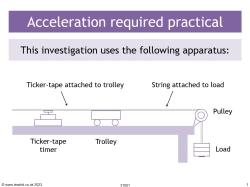Acceleration required practical – measurement and calculations

This resource provides everything students need to succeed in the required practical on the relationship between force, acceleration and mass. It is suitable for GCSE physics or combined science.
The PowerPoint presentation recaps the equations for calculating acceleration, including Newton's second law. It then provides the method for an investigation using a trolley, a light gate or ticker-tape timer, a pulley and masses of 100 g, along with diagrams showing how to set up the apparatus.
Questions to test students' understanding, and to practise measurement and calculations, are provided both on the PowerPoint and as a printable worksheet. They include questions about the results of the investigation and about velocity-time graphs. Answers are included.
An extract from the answers:
The boat undergoes constant deceleration until it is stationary as the velocity decreases directly with time. This is shown on the graph by the straight line sloping down from left to right. The negative gradient of this slope is the deceleration.
